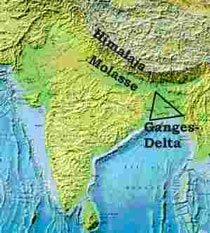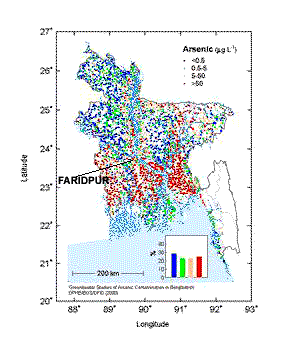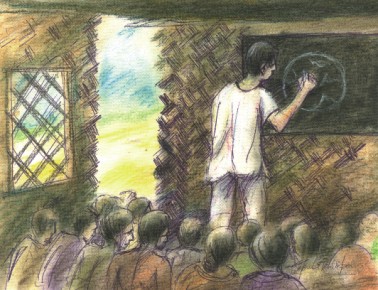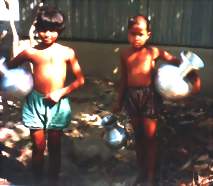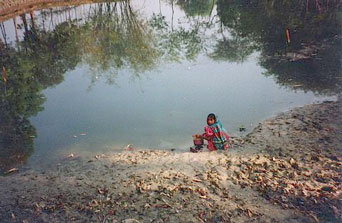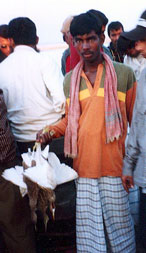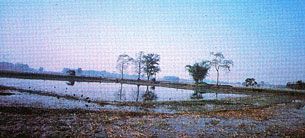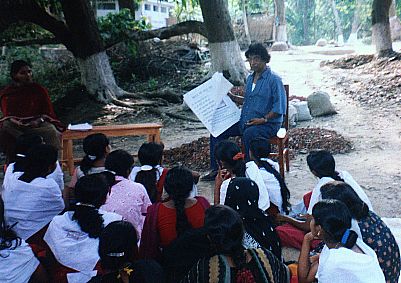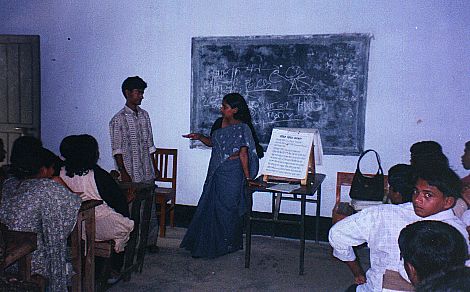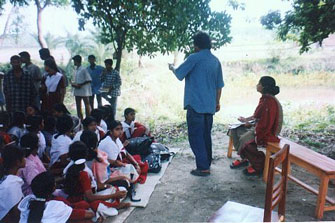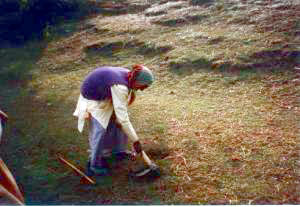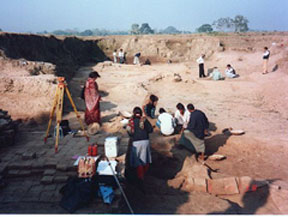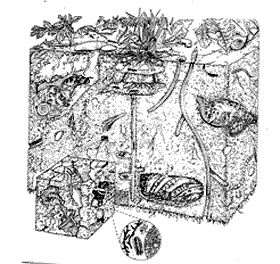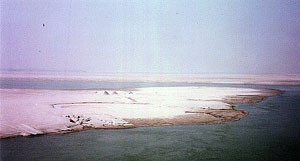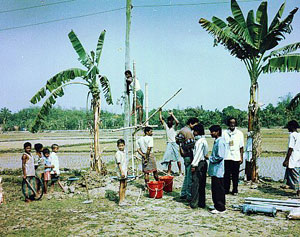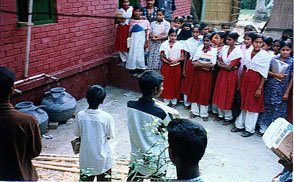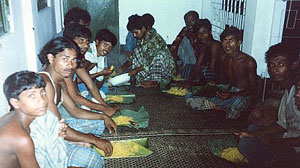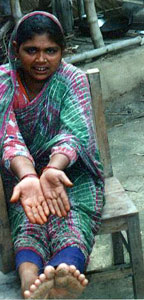ENVIRONMENT CONSCIOUSNESS EDUCATION ARSENIC AND WATERBORNE DISEASE FREE WATER
A PILOT PROJECT
For Teachers and Children (Schools)1. INTRODUCTION
No water-purification device is capable, by itself, of removing all of the toxics from drinking water. Many unscrupulous companies and salespeople sell water-purification equipment to cash in on people's fears about polluted water to make quick money. No programme for creating an awareness among the people about arsenic contamination, water management, nutrition or which measures to take to face the arsenic threat appears to have been taken up (Sylvia Mortoza, 10. 05. 01).A study in Thailand shows that drinking arsenic contaminated water influences children's intelligence. The study of intelligence levels among case and control alerts us that the arsenic contamination and poisoning is not limited to the Ronpibool District but is spreading to the district of Sao-tong and possibly several more. At a certain level, arsenic has a significant effect on the children's development and learning abilities of children as shown from the IQ study (Chanpen Choprapawon, 2001).
Millions of school children (5-17 Years old) are drinking arsenic contaminated water. Almost 80 percent of rural population is analphabetic. Arsenic mitigation can be highly successful, if school students/teachers can be educated and transfer their knowledge to their parents and neighbours. The aim is that "learning by doing", to work out simplest ways to obtain arsenic free water and environmental conscious education.
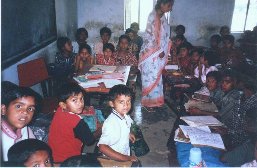
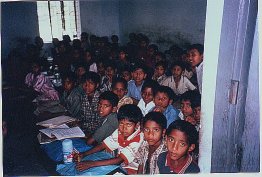 About 120 students in a class. No money for education.
About 120 students in a class. No money for education.
Five teathers for sixhundred students.
This project proposal is different than other projects. We intend to introduce traditional methods - by the school students and for the students and parents. This extraordinary project is based on traditional wisdom of the rural population of Bangladesh to help the poorest group with meaningful assistance that can reproduce and distribute the knowledge to others not only to obtain arsenic free water but also sustainable development of social, cultural and traditional heritage.
The NGOs and companies distribute the filter but due to clogging, no device for back-washing and colouring of water, growth of pathogen within the filter and expensive to replace etc. people refuses to use them: Available arsenic removal technologies are neither cost effective for the poor nor easily operable and maintainable. For example devices based on sorptive techniques need periodic regeneration by washing as flocculate particles clog the filter media slowing down flow rate which makes those devices cumbersome to use After some days there may arise filter media which demands extra replacement cost.
The risk of harmful bacteria can grow and increase substantially within the filter, if it is not properly maintained. Another process is coagulation-flocculation-co-precipitation with chemicals that may leave harmful residual elements in dissolved state in water. If coagulated with alum and potassium permanganate, there is a chance of having residual aluminium, potassium etc. in treated water that may have toxic effects on human nervous system. DPHE and DANIDA have introduced this system. In Faridpur they have distributed two-bucket system, but no body uses it.
- There are several expensive filters are available in the market, but nobody knows their effectiveness.
- None of the project has arsenic disposal programme.
- Agencies have failed to give the people arsenic free water, environmental conscious education
- After reviewing present situation on the basis of peoples educational background, acceptability and tradition the following aims have been suggested:
- In Bangladesh most of the rural population is still uneducated and most of the arsenic mitigation projects have been failed. Teachers and students are targeted for environmental education and can make greater impact on their parents.
- Our goal is to transfer knowledge on water, air, and soil - special emphasis on water. How to combat present disastrous situation through arsenic poisoning.
- Remove social isolation of arsenic affected students.
- Enhance traditional wisdom to combat arsenic poisoning and environmental degradation in rural Bangladesh;
- Priority of the project is to give people an immediate cheap solution. Our studies show that "Open Dug Holes" with filters is the simplest solution. But we aim to obtain waterborne disease free water at affordable means.
- Arsenic contaminated water from the tube wells will be removed by simple clay pot filter (Sun-air-Clay Pot Method). The villagers will do production and maintenance of the filter. Villagers will produce clay pots, sand filters, microbial disposal etc. and later distribute to other villagers and thus a rapid mitigation project can spread all over Bangladesh.
- Rain water harvesting with affordable means.
- To find out alternative arsenic free water. Experience has shown that tube wells near water pond contains less arsenic, at particular depth water is arsenic free, aquifer on channel sand in particular area arsenic free etc.
- Introduce Village Home garden for medical and bio-pesticide production. Home garden represents the blending of knowledge gained by ecologists studying the dynamics and stability of tropical ecosystems with the knowledge of farmers and agronomists on how to manage the complexities of food producing ecosystems.
- Women's participatation.
- Cultural and traditional heritage.
- Stop using aluminium, polythene products and use of natural products.
2. AREA OF THE PROJECT
British Geological survey (1998) has compiled nation-wide distribution of arsenic in groundwater at union level on computer and geocoded to thana (Police Station) level that indicates that southwest region is extensively contaminated. The most intensely contaminated areas are found along the Lower Meghna in the greater districts of Comilla, Noakhali, Kustia and Faridpur. But more arsenic contaminated areas are discovered after water test. Faridpur is one of the "hotspot" worst arsenic affected areas of Bangladesh.
3. AIM OF THE PROJECT
We intend to introduce 6 arsenic free water units for 6 schools in the rural area of Faridpur district. In other words about 7, 000 students will get arsenic free water, education and environmental consciousness that will influence their parents. More than 60 percent of the students in rural Faridpur are women.
Infants and young children can be more vulnerable to chemicals and other pollutants in the food they eat because pollutants can impact their developing systems resulting in lifelong effects. Children also eat three to four times more food in proportion to their body size than adults, which means they ingest proportionately more chemical and infectious agents. Children are also more likely to eat with unwashed hands and to ingest food that has been in contact with the ground or floor, thus increasing their exposure to foreign substances.
Infants and young children also have a less varied diet, relying more on fruit and milk products, which can greatly increase their exposure to certain environmental contaminants. You can prevent environmental risks to your children by ensuring they have a balanced diet with good nutrition, and avoid eating large quantities of foods with potentially high levels of pollutants.
The principal goal of this project is to introduce environmental consciousness education, least cost-effective, efficient and appropriate method of water purification, arsenic removable, health and disposal in the light of adaptability, social acceptance, sustainability and easy reproducibility within Bangladesh environment:
- Awareness through environmental education will not only create sustainable development and protect health but will also lead to successful arsenic mitigation projects;
- The only way to ensure safe water is definite steps in the project that safeguard quality of water;
- Teachers and students are the most powerful ambassadors of present and future generation in a country where majority of the population is analphabetic.
- Village School committees who will be trained to look after water
- Purification and disposal units, health and environmental aspects;
- Regain traditional wisdom and peoples acceptability on the quality of water and methods of purification;
- Alternative water (arsenic free);
- Dug wells water pumps with special emphasizes to obtain water bacteria and arsenic free for 40,000 students;
- Biological method of water purification;
- Cheapest disinfect ion (removal of pathogenic bacteria and viruses) method of water purification;
- New place of tube wells. If tube well near water pond is arsenic free or low arsenic, aquifer on channel sand etc. advise to shift other tube wells to this site
- Introducing inexpensive sand filter using local clay pot, sand (and charcoal, if water is contaminated with pesticides, etc.). Cleaning, maintenance and self-production of sand filter, which can be easily, reproduce all over the country.
- Women for water sharing;
- Innovating clay potters to introduce optimal water containers and sand filters and importantly protecting dug wells from surface and surrounding geological formation.
- Disposal of arsenic precipitates in cow-dung pits or sanitary.
- Introduction of bio-pesticides and additional income through home- garden.
- Stop using polythene and aluminium products. Export of natural sustainable products from villages to cities.
- Cultural and social meetings for transfer of knowledge, environmental consciousness and to solve social conflict.
The educational topics are:
1. ENVIRONMENTAL EDUCATION
1. 1. Water
1. 2. Surface Water
1. 3. River and Streams
2. GROUND WATER
2. 1. Ground Water Aquifers
2. 2. Movement of Ground Water
3. WATER WELLS
3. 1. Types of Water Wells
3. 2. Water Level in Wells
4. WATER SUPPLY
5. WATER TREATMENT
6. DRINKING WATER STANDARD
7. PROTECTION
7. 1. Pollution Prévention
7. 2. Threats to drinking water
7. 4. HOW CAN I PROTECT MY WATER?
8. STOP USING POLYTHENE
9. PROTECT MIGRATORY AND NATIVE BIRDS
10. PESTICIDES
10. 1. Protecting Public and children
10. 2. Banned Pesticides
10. 3. Safer Pesticides
11. VALUES AND FUNCTION OF WETLANDS
11. 1. Wetland supports Many Spices
11. 2. Ecological Benefits
12. Questionnaire
13. ARSENIC EDUCATION
13. 1. What Happens to Arsenic When Enters the Environment
13. 2. How Might I be Exposed to Arsenic?
13. 3. Metabolism and Excretion
13. 4. How Arsenic Affect My Health?
14. EFFECTS OF HEAVY METALS
15. ARSENIC IN TUBE WELLS
16. WATER FILTRATION
17. REMOVAL OF ARSENIC
17. 1. TECHNOLOGIES
17. 2. METHODS
18. Open Dug Holes
18 1. Dug Well Survey
18. 2. Drinking from Dug Wells
18. 3. Construction of Dug Wells
19. MONITORING PATHOGENE
19. 1. Removal of water-borne Pathogen
20. SAND FILTER
21. CHEMICAL DISINFECTIONS
22. UV DISINFECTION
23. REMOVAL OF ARSENIC FROM WATER
24. DISPOSAL OF ARSENIC
25. Home Garden
25.1. Bio Pesticide
26. Rediscover Traditional Wisdom4. PROGRESS REPORT PHASE 1
March 8 to April 23, 20002.
The following items are the milestones of the project (Phase: 1):
- Environment Consciousness Education for school students and teachers
- Selection of location after drilling and construction of Dug Wells.
- Dug well filter
- Identification of facies change within contaminated area and locate and construct arsenic free wells
- Rainwater collection (harvesting) and filtration
- Water Filter with local materials
- Arsenic Free Village
4. 1. ENVIRONMENT CONSCIOUSNESS EDUCATION FOR SCHOOL STUDENTS AND TEACHERS
Selection of Schools:
- Demrakandi Primary and High SchoolKoijori Union, Faridpur.
- Khalilpur Primary and High school
- Ansaruddin High school
- Kanaipur Primary High School
- Primary School Teachers.
Photos: photo: school lesson1.jpg, school practical 1.jpg Students of class 9 and 10 attending theoretical and practical courses.
Children
Infants and young children can be more vulnerable to chemicals and other pollutants in the food they eat because pollutants can impact their developing systems resulting in lifelong effects. Children also eat three to four times more food in proportion to their body size than adults, which means they ingest proportionately more chemical and infectious agents. Children are also more likely to eat with unwashed hands and to ingest food that has been in contact with the ground or floor, thus increasing their exposure to foreign substances.
50 percent population of Bangladesh is less than 17 years old. Infants and young children also have a less varied diet, relying more on fruit and milk products, which can greatly increase their exposure to certain environmental contaminants. You can prevent environmental risks to your children by ensuring they have a balanced diet with good nutrition, and avoid eating large quantities of foods with potentially high levels of pollutants.
Pesticides
Pesticides are substances intended to destroy, control or repel pests, such as insects, weeds, fungi, rodents, and bacteria. Depending upon the dose, pesticides may cause a range of harm such as cancer, acute or chronic injury to the lungs, nervous, reproductive, endocrine and immune system damage and may accumulate in the environment. Children are at greater risk of pesticide exposure than adults because pound for pound of body weight, children not only eat more and breathe more, but they also have a more rapid metabolism than adults and they play on the floor and agricultural fields/lawn where pesticides are commonly applied.
A child is taking water from the pond, a red flag indicating pesticide has been used to kill all living organisms - pre treatment for aqua fish culture. Water is contaminated with Endrin (Dirty Dozen), a banned pesticide.
Pesticides are used in Bangladesh to conserve food, wood, stored with daily household goods etc. Without knowing that they can cause serious health hazards. There are innumerable reports of deaths in the newspapers on pesticide poisoning e.g.- the whole family died after eating spinach that was handled with dangerous pesticides.
PROTECTING MIGRATORY AND NATIVE BIRDS
About 200 species of migratory birds arrive in Bangladesh during winter months. More than 129 species of residential birds contribute faunal diversity. Twenty-five species of resident and migratory bird are endangered and threatened and the rest are vulnerable (IUCN, 1997).
Increasing use of hazardous pesticides, disappearance of wetland, pollution of industries has dramatically reduced biodiversity and specially birds. Nature can live without us, but we cannot live without nature. Birds eat many harmful insects and reducing birds mean we have more harmful insects.
The most shocking news about killing migratory bird is that children from very low-income family collects small fish and apply a dangerous pesticide locally named "Furfurans" to trap birds in the wetlands. As soon a bird eats a small portion of the fish dies immediately and the children cut the head for daily meal!!! A parent at Shibrampurr was proudly describing how his son brought fourteen birds for evening meal.
Killed migratory birdIt is sad to notice that migratory bird are openly sold in the market and many school going boys in rural areas kill unnecessarily birds with air gun.
It is necessary to make consciousness education and regain traditional Bengali heritage to protect our "loving birds".
Water
People are asking many questions. How safe is my drinking water? Where does my drinking water come from, and how does it get to my home? My water may be safe now, but what about in the future? What can I do to help protect my drinking water?
Drinking water comes from surface water and ground water. Large-scale water supply systems tend to rely on surface water resources, and smaller water systems tend to use ground water.
The contaminants in drinking water are quite varied and can cause a range of diseases in children, including cancer, developmental effects such as learning disorders, and acute diseases such as gastrointestinal illness. Children are particularly sensitive to microbial contaminants because their immune systems may be less well developed than those of most adults. Children are sensitive to lead, which affects brain development, and to nitrates, which can cause methemoglobinemia (blue baby syndrome).
Microbiological and chemical contaminants can enter water supplies. These materials can be the result of human activity or can be found in nature. For instance, chemicals can migrate from disposal sites and contaminate sources of drinking water. Animal wastes and pesticides may be carried to lakes and streams by rainfall runoff or snow melt. Human wastes may be discharged to receiving waters that ultimately flow to water bodies used for drinking water. Coliform bacteria from human and animal wastes may be found in drinking water if the water is not properly treated or disinfected. These bacteria are used as indicators that other harmful organisms may be in the water.
You can protect your water supply by carefully managing activities near the water source. For households using a domestic well, this includes keeping contaminants away from sinkholes and the well itself. Hazardous chemicals also should be kept out of septic systems.
Source water protection works by involving all members of the community. Citizens can voice their support for controlling how land is used near drinking water intakes. Citizens can also educate their neighbours about the danger that household chemicals pose to drinking water supplies. Many communities sponsor household hazardous waste disposal days to promote proper handling of waste paints and thinners, pesticides, used oil, and other hazardous materials.
To protect public health and the environment from the risks posed by pesticides and to promote safer means of pest control. In Bangladesh several people dies because of pesticide poisoning. Many traders use pesticides to conserve dry fish, rice and lentils in Bangladesh.
Wetland
Two third of Bangladesh is wetland. Protection of wetland has enormous importance for protecting environment and economy of the country.
Wetlands provide many benefits, including food and habitat for fish and wildlife; flood protection; shoreline erosion control; natural products for human use; water quality improvement; and opportunities for recreation, education, and research.
What is arsenic?
- Arsenic is found in nature at low levels. It's mostly in compounds with oxygen, chlorine, and sulphur. These are called inorganic arsenic compounds. Arsenic in plants and animals combines with carbon and hydrogen. This is called organic arsenic. Organic arsenic is usually less harmful than inorganic arsenic.
- Most arsenic compounds have no smell or special taste.
- Inorganic arsenic compounds are mainly used to preserve wood. They are also used to make insecticides and weed killers. You can check the labels of treated wood and insecticides to see if they contain arsenic
- Arsenic is found in nature at low levels. It's mostly in compounds with oxygen, chlorine, and sulphur. These are called inorganic arsenic compounds. Arsenic in plants and animals combines with carbon and hydrogen. This is called organic arsenic. Organic arsenic is usually less harmful than inorganic arsenic.
- Most arsenic compounds have no smell or special taste.
How might I be exposed to arsenic?
- Breathing sawdust or burning smoke from wood containing arsenic
- Breathing workplace air
- Ingesting contaminated water, soil, or air at waste sites
- Ingesting contaminated water, soil, or air near areas naturally high in arsenic
- Through arsenic contaminated food.
Long Term Effects of Heavy Metals
Arsenic
- Chronic arsenic poisoning, whether through ingestion or inhalation, may be manifested by many symptoms. Digestive disturbances such as nausea, cramps, constipation or diarrhoea with associated weight loss are likely, and liver damage may also occur.
- Disturbances of the kidneys, the nervous system and of the blood, such as anaemia, are not infrequent.
- Arsenic may cause a variety of skin abnormalities, including itching and pigmentation. These effects may result from dermal exposures or from systemic distribution.
- Chronic dermatitis commences with patchy erythematic and may lead to papular or vesicular eruptions. Optic and peripheral neuritis may also develop with prolonged exposure. Aplastic anaemia has also been observed.
HOW COULD I BE EXPOSED TO ARSENIC?
Since arsenic is a natural part of our environment, everyone is exposed to some amount of arsenic. A person could come in contact with arsenic in any of the following ways:
- Arsenic can be consumed by either drinking arsenic-contaminated water or by eating food that has been cooked in this water. Arsenic may be inhaled by breathing in dust or smoke that contains arsenic. Smoke could come from burning wood treated with preservatives, the dust from industrial process. Some industries use arsenic compounds that can be absorbed through the skin if direct contact occurs. Arsenic in water or food does not evaporate into the air, and is not easily absorbed through the skin.
- The largest source of arsenic comes from the food we eat every day. Some fish and seafood contain high amounts of organic arsenic. This type of arsenic is much less harmful to humans than inorganic arsenic from the groundwater.
WILL ARSENIC IN MY WATER CAUSE HEALTH PROBLEMS?
If you are exposed to arsenic, several factors that work in combination with each other will determine whether harmful health effects may occur. These factors are:
- DOSE - How much arsenic am I exposed to?
- DURATION - How long and how often have I been exposed?
- TYPE of ARSENIC - Have I been exposed to inorganic or organic arsenic?
- GENERAL HEALTH, NUTRITIONAL STATUS, AGE, and LIFESTYLE
WHAT SHOULD I DO IF THERE IS AN ELEVATED AMOUNT OF ARSENIC IN MY WATER?
- Arsenic guideline. Generally, samples taken weeks or months apart have not shown significant change in arsenic levels.
- We recommend that you stop using your well water for drinking and preparing food. Skin contact with groundwater containing arsenic will not result in significant exposure. Use rain water, water from open dug holes (take care about biological contamination)
- Connection to a public water supply system is the best solution. For example, Faridpur town water supply water contains less arsenic than permissible standard. When this is not possible, well replacement or modification may be an option. However, well modification may not always be effective.
- Keeping the water over night in a clay pot can reduce arsenic but about 70 percent arsenic is reduced - still too high for drinking and cooking.
WATER FILTRATION
Water in lakes, rivers, and swamps often contains impurities that make it look and smell bad. The water may also contain bacteria and other microbiological organisms that can cause disease. Consequently, water from surface sources must be "cleaned" before it can be consumed by people. Water treatment plants typically clean water by taking it through the following processes:
(1) aeration;
(2) Coagulation;
(3) Sedimentation;
(4) Filtration; and
(5) disinfectionREMOVAL OF WATER-BORNE PATHOGENS
The following methods of disinfect ion is carried by the water supplies all over the world:
- 1. Disinfect ion By Coagulation, Settling,
- Filtration and adsorption processes
- 2. Chemical Disinfect ion-
- Chlorine
- Iodine
- Bromine
- Ozone
- 3. Alternative Disinfectants:
- Heat Treatment
- Ultraviolet Irradiation
- Metal Ions
SAND FILTER
The versatility of the sand filter is reflected in the numerous design variations that have been developed to address many different climatic and development conditions
Slow Sand:
It incorporated sand with an effective size of fine sand. This very fine sand produced good quality of water of low turbidity.Rapid Sand:
Rapid sand filter might vary in effective size of coarse sand.Mixed Media:
Development of the coarse-to-fine principle of filtration has taken place in two major steps. Basically this provides a two-layer filter in which coarse upper of coal (sp.gr. 1.4) acts as a roughing filter to reduce the load of particulates applied to the sand (sp.gr. 2.64) below. Dual media filter can retain more material removed from water than sand filter. The size of the media particles should be uniformly graded from coarse-to-fine in the direction of flow through a filter bed.ARSENIC WASTE DISPOSE OF COWDUNG OR OPEN SANITARY
US Environmental protection agency describes microorganism can transform to gaseous arsenic hydride. Arsenic waste can be disposed on a prepared bed of cow dung in a shallow hole dug in earth or each house in the villages has for the women sanitary (Kacha Paykhana). The microorganisms in cow dung or in the open sanitary transform the arsenic to gaseous and arsenic is thus released into the surrounding air. Bangladesh has the advantage that the industrial countries do not enjoy to dispose of arsenic sludge into cow-dung or open sanitary at zero cost.
HOME GARDEN- - TO SAVE HERBS AND TRADITIONAL PLANTS FROM EXTINCTION
This project intends to support traditional plants that are threatened to extinct.
Haldi- Turmeric- Curcuma long - The Spice of Happiness and Festival
To most Indians and Bengalis, turmeric or halud (Bengali)/ haldi (Hindi), is a part of growing up, a magic cure-all for the excesses of childhood. A classic "grand mother's remedy', the virulent yellow powder or paste has been applied to scrapes and cuts of generations of children (A. Agarwal and S. Narain,1996).
Haldi (turmeric) is not only the most important spice in Curry, it has many known medical use sine hundreds of years. Used as a stimulant in native medicine. Often administered in disorder of the blood. Its use as an external applicant in bruises, leach bites etc., is perhaps ithe most frequent medical application. Haldi has been used as a wound-healing agent can be found in 200-year-old Ayurvedic scripture. These traditional knowledge systems are communicated by word of mouth. Now the western scientists have 'discovered' our traditional bio-resource as a part of profit, as they intend to trade. The use of haldi (turmeric) comprises:
- Increase immune system
- Treating muscular-skeletal disease
- Wound healing
- Dye
- Detect and warn cyanide adulterated food products
- Liquid seasoning compositions
- Metal colour complexes
- Tinted pit and fissure sealant
- Colouring process and composition for food and beverages
- Process for producing water and oil as a colouring agent
- Conservation food (fish, meat, cooked food);
- Improve intestinal haemorrhage, bowel function, stops irritating substances, reduces fatty compounds and perhaps stops cancer etc.
Now about 12 patents have been registered in the USA although turmeric has long been used in India as a traditional medicine for treatment of various sprains and inflammatory conditions (Indian Journal of Medical Research, 1982). A lack of regulations is allowing foreign scientists to claim exclusive ownership of traditional medicine that we have used for centuries.
While travelling arsenic affected areas in Bangladesh, it was a great surprise, to hear that many arsenic affected women after trying many modern medicine switched to the juice of raw Haldi (turmeric) and found astonishingly good result. Use of turmeric is widely known in ancient Ayurveda.
Hamida of Village Purobagangabarti, palm before haldi treatmentAt Purboganabarti Village Hamida, an arsenic patient with arsenic lesions on hand palm was advised to take green curcuma juice and arsenic free water. After six weeks her lesions began to disappear.
Neem Azadirachta indica The Wonder Plant
In ancient Sanskrit literature (1500 BC) Neem regarded as life saving and disease preventive plant. It belongs to the family Meliaceae.
Leaf, bark, seed and all part of Neem tree contain useful substances that can be taken as tee, oil and prepared medicine remedy dust allergy, fever, skin diseases, rheumatism etc (Roemmming, 1999, Nature). Professor Heinz Rembold, of famous Max-Planck Institute of Biochemistry, Germany found any side effects of the use of Neem on human and soils do not contain any hazardous substance as a residue after being used as pesticides.
Research conducted by, among others, United States Department of Agriculture (USDA) has shown that Azadirachtin A offers protection against more than 130 insects, while it is partly active against more than 70 other insects. Since the potential value Neem-based pesticides was recognised, commercial interests have been increased
We have visited several schools of Faridpur District. Some School committees were reluctant to take part with the project. It seems that committee members of some schools want personal benefits e. g. Shibrampur High School, Union Ambikapur, Rousennessa Primary School, Shameshpur, Union Koijori although the students are drinking highly contaminated water.
4. 2. Educational Material in Bengali
108 pages of educational material for students and teachers and charts are prepared and distributed among students and teachers.
- Demrakandi Primary and High SchoolKoijori Union, Faridpur.
10 hours of courses have been completed in this school. 70 percent students are female.- Khalilpur Primary and High school
8 hours of courses have been completed in this school.- Ansaruddin High school
12 hours of courses have been completed in this school. 70 percent students are female.- Kanaipur Primary High School
8 hours of courses have been completed in this school. 70 percent students are female.- Primary School Teachers.
Primary school teachers of Koijuri Union have agreed to take part the course on a day program. This will held during 2nd phase of the project.
4. 3. COMMENTS
The course has no compulsory binding but attendance is very high. The students took keen interest on outdoor studies. Lectures from local doctors, dug hole constructors, rainwater constructors, clay potters and farmers etc. made the course lively and easy understandable. The female students took more interest and stated that if they knew these aspects they would have taken science as a major subject. About 56 percent of the course has been completed. Students show keen interest in out door courses
It is pity that there is any course in sport, music and painting in school education system of Bangladesh.
Students are attending course on water and wetland.Excursion for example a visit to Water Supply, Water purification units, wetlands etc. was not possible due to rejection of field trip by SEMP.
5. OPEN DUG HOLES
An Easy Alternative to Obtain Arsenic Free Water Our studies show that dug wells do not contain arsenic (very low), where as neighbouring tube wells contain extremely high amount of arsenic in water. "Dug well" is an indigenous technology and social acceptance is very high and can be constructed with local available source.
Construction of such wells with terra cotta rounded clay slabs; walls protected with clay jute layers etc. can provide bacteria free water. Simple sand filter produced and maintained by the villagers can eliminate bacteria. Unfortunately these dug wells are very rare and almost vanished after the introduction of tube wells. Such dug wells can be constructed only during dry period.
Dug hole Constructor :
Siraj Miah 75 years old
Khoad, 93 years oldDug well can be used in villages of West-Bengal-India and Bangladesh for drinking purpose after taking care of bacterial contamination & assessing the quality of water. Water from open dug hole can be improved through protective measures.
Pathogen, bacteria, viruses can be removed through solar radiation (no cost) and other methods at site acceptable appropriate measures. It is easy to remove bacteria but present experience in Bangladesh and India show that household methods of arsenic removal have totally failed but donors and NGOs ("more monitoring is required for these filters before it can be recommended") are continuing to fruitless target.
The British Geological survey (BGS, 1998) suggests that within the zone of water table fluctuation and where residence times are short, arsenic is flushed away or immobilised.
- Dug wells are indigenous technology in Bangladesh.
Ancient dug wells at Mahastan (300 B.C.) recently excavated by Lyon University, France.- The wells are cheaper and easier to construct and less susceptible to bacteriological contamination (BRAC, August 2000).
- Natural biological filtration occur, when water percolates through sand bodies (develop microbial flora whose metabolism contributes to the effectiveness of removing effluents)
- In dug wells within the standing water simple sedimentation take place and has been found frequently a substantial reduction in BOD (Biological Oxygen Demand).
- Natural iron coagulation and settlement occur within standing water (decrease in arsenic, suspended solids, ammonia, nitrate and phosphate content).
Soil Purifies Water
Santee, California, USA, a suburb of San Diego provides unusual approach to sewage treatment. Water is pumped from oxidation ponds into one or another of the basins, where it slowly soaked through soil. The water is purified variety of ways while it is contact with the soil:
- First, it is filtered ; contaminants in the wastewater become lodged in the voids and spaces that exist in all soils, much as occurs in an activated carbon filter (Coffel, 1991).
- Some toxic are rendered harmless when they react with elements in the soil;
- Others become part of the soil;
- Countless microbes inhibit in most soil. Microorganisms in soil remove nitrogen, Germs, bacteria, and viruses.
Microflora and -fauna in soilState officials of Santee were far from convinced that the system would produce really clean water. They were especially concerned that viruses would find through the system.. However, after extensive testing, with special attention to viral organisms, the state approved the water.
Soil is, in fact, more resilient in handling the constantly changing blends of toxic materials. The diverse community of organism present in soil are better able to react to changes in the chemistry of the wastewater to be treated. Soil filters are more effective when plants are grown on them.
Surface water percolates through (4-6 meters) soil, silty sand and accumulates in fine to medium sand (aquifer) of dug wells. If dug wells are constructed with proper care, natural biological system removes nitrogen, germs, bacteria and viruses.
Our ancestor knew this wisdom. Even now people say, "Drink crystal clear water. Don't drink water with micro-organisms!"
Selection of location after drilling geological formation and construction of Dug Wells:
The following areas have been selected after drilling and formation evaluation :
- Khalilpur High school 1 Dug Well
- Khalilpur Bazar 2 Dug Wells (One failed due to lack of water aquifer)
- Demarakandi School 1 Dug Well
- Mirgi Primary School 1 Dug Well
- Purbo gangabarti Village 6 Dug Wells
- Mallick Pur 1 Dug well
TOTAL = 13Achievement more than 200 per cent.
Reconstruction of abandoned Dug Wells Number 6
Total Dug Wells Number 19
Photo: Indigenous Technology of Drilling - Bamboo, pipe, water. Participation of Students and Villagers:
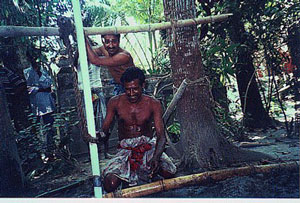
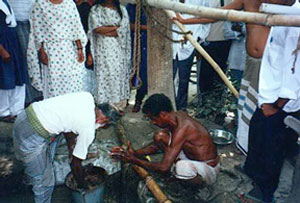
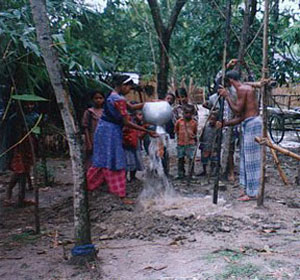
LINK:IMAGES OF NEW DUG AND RENOVATED DUG WELLS PHOTOS: DUGWELL 1-5.JPG, RENOVATION1-6.JPG
6. IDENTIFICATION OF FACIES CHANGE WITHIN CONTAMINATED AREA AND LOCATE AND CONSTRUCT ARSENIC FREE WELLS
There are wells that are highly contaminated but a few wells show ground water arsenic concentration is far below Bangladesh standard. It may sound puzzling but the aquifers are different. Local relief and rivers impact on the direction and velocity of groundwater flow and therefore on the migration of arsenic. Groundwater flow from high to low relief causes deeper penetration contaminants into the aquifer. The reverse is true in areas that are low in relief. Here upward groundwater movement would bring contaminants to shallower horizons.
Photo: Modern mid channel bars in Brahmaputra River. Such aquifers in ancient channel bars show in many cases arsenic free.
A sound knowledge on underground geology, hydrology it is possible to identify arsenic free aquifer at shallow depths. This is a very cheap and highly acceptable alternative.
We have identified a channel sand facies at Khalil Pur, Faridpur
At Khailpur most of the wells are arsenic contaminated but in some areas a few wells found to be arsenic free. At Kahailpur after 12 drilling arsenic free aquifer has been identified at depths 40-55 feet within channel sand facies.
This method can be applied to other areas for easy and cheap access of arsenic free water. This needs careful formation evaluation and routine monitoring. Hammer drilling equipment or vibro-core is required, unfortunately it is not available in Bangladesh.
7. Rainwater collection (harvesting) and filtration
Rainwater harvesting -- in one form or another -- has been in practice for thousands of years. According to Paul Woods of Texas A & M University, extensive water harvesting systems in the Negev Deserts of Israel more than 2,000 years ago have been documented. Rainwater collected in various parts of the USA contains (in milligrams per liter): Fe (0.015) , Ca (0.075-1.41), Mg (0.027-1.2), Na (0.22-9.4), Ca (0.075-1.41), K (0.072-0.11), HCO3 (4-7), SO4 0.7-7.6), Cl (0.22-17), NO2 (0.02), NO3 (0.02-0.62), and Total Dissolved Solids 8.2-38), and pH of 4.9 to 6.4. Most of these concentrations fall within the safe limit prescribed by the US Environmental Protection Agency, some exceed safe drinking water limit.
There is a long established tradition of rainwater collection in some parts of Alaska and Hawaii. City of Austin, Texas, offers rebate for using rainwater for some household uses. According to the "Sourcebook Harvested Rainwater", in some areas of the Caribbean, new houses are required to have rainwater capture systems. Hawaii apparently is currently developing (or has already developed) guidelines. The island of Gibraltar has one of the largest rainwater collection systems in existence. Rainwater offers advantages in water quality for both irrigation and domestic use. Rainwater is naturally soft (unlike well water), contains almost no dissolved minerals or salts, is free of chemical treatment, and is a relatively reliable source of water for households.
Studies in Thailand, India, and Sri Lanka, show that properly stored rainwater is safe from bacteria, and can be stored for many months Also, research in Bangladesh by the International Centre for Diarrhoeal Disease Research, Bangladesh, (ICDDR) confirms that rainwater can be a safe drinking water source. Rainwater is very low in dissolved minerals, and as such is relatively corrosive. This lack of minerals may also cause mineral deficiency in the diets of poorly nourished consumers. Fruits like banana, mango, jackfruit etc. are advised to take regularly. The relative purity of rainwater makes it an attractive option in areas with uniformly high arsenic levels in other water sources
Rain water harvesting
Students learning about rain water harvestingWe have found keen interest on rainwater collection in the arsenic affected areas. We have selected all local materials and local carpenters and potters made rainwater collecting 12 units at worst affected poor rural areas. Water filter is also under construction. It is possible to collect a huge amount of rainwater. Rainwater collection makes the life of the women comfortable as they do not require carrying water from a long distance. Rainwater collection and filtration will be emphasizing during 2nd phase of the project. Advertisement in the newspaper to use rain- water does not have any affect on villagers. If simple method is shown practically, the villagers can easily repeat it.
The development of a rainwater-harvesting plan that is economically and technically feasible for the majority of the people in Bangladesh should be given high consideration as a part of the integrated water resources management plan.
Link: IMAGES OF RAINWATER HARVESTING
8. Water Filter with local materials
Water Filter will be produced at 2nd phase of the project as clay pot cannot produce at this time of the year. We have set filter at a dug hole. If this experiment becomes successful, all dug holes will be equipped with such natural filter. No chemicals will be required for water purification.
9. Arsenic Free Village
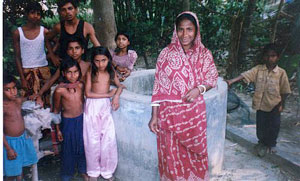
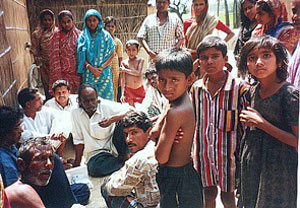
Purbo Gangabarti Village, at Koijorri Union, Faridpur is one of the worst arsenic affected areas of Bangladesh. 12 persons have already died and several at present suffering from arseniocosis because of drinking arsenic contaminated water. Villagers do not have any alternative but to drink arsenic contaminated water.
The following persons are dead due to drinking arsenic contaminated water:
- Golapi Khatun
- Kader Mollah
- Sobar Mollah
- Suratjahn Begum
- Surhab Mollah
- Surju Begum
- Sader Mollah
- Jalil Mollah
- Golapi Begum
- Korban Mollah
- Azahr Mollah
- Shaed Mollah
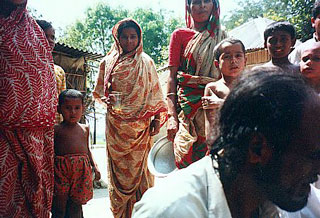
We have made available to all villagers to obtain arsenic free water. We have achieved a very cordial relation with the villagers. Villagers prepared food, rice cakes for the workers. We have installed 7 dug holes and 25 rainwater-harvesting units in this village.
10. SOCIO-CULTURAL EVENTS
An ancient Bengali mystic poet describes:
The mind is a tree; the five senses are its branches.
Hope bears fruits and leaves in abundance.
One who does not know the mystery
of this tree's growth and destruction.
Fool is he to have to come back again and again
in samasara to receive pain.
(From Cayapada 45, Kanhupada, Raga Mallari)We organised two village concerts on traditional Bichar Gan "Song of Justice" which continued the whole night. Motivation through traditional cultural heritage can conquer many obstacles. Mumata a twenty two year young folk -singer spell bound the audience by her simple arguments and traditional music.
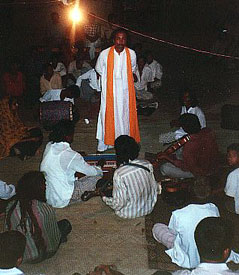
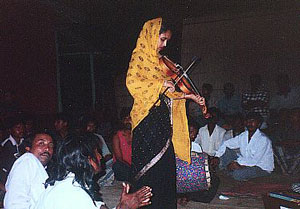
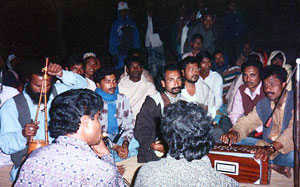
After concert Vegetable-Lentil-Rice on Banana LeafTraditionally this country lived with harmony to nature, which reflects in ancient Boul, Murshidi, Jari, Bhatiali songs. Bangladesh has developed over the centuries an excellent social situation based on humanism and secular thought - a very modern trend of social advancement Europe had known during the renaissance.
Mainly four streams mingled in this social thought process - tribal anthropomorphism, Buddhist nihilism, Hindu vaiishnavism and Muslim sufism. These four historical forces plus the various local mystic cults of different obscure religious sects which cast and class distinction and autocratic establishment prompted ancient Bangladesh to develop with the hopes fought relentlessly against religious fundamentalism, orthodoxy, fanatism, crude and aspirations of the common men and their philosophy synthesis. Social dynamics of rural Bangladesh is rooted in this cultural synthesis and religious tolerance.
In the 16th Century Bangladesh was the first and only country in the world that introduced religion freedom and during this time the country flourished at its highest peak. There are many accounts and references, which point out that the ancient people of Bengal, were different in race, culture and language from the Aryans. The original inhabitants of Bengal were non-aryan. According to Sylvan Levi, the primitive people of Bengal spoke a language that was neither Aryan nor Dravidian, but belonged to a separate family. Lying at the crossroads of South Asia and Central Asia, Bengal attracted people from early civilisation of the Fertile Crescent.
It is now generally held that the Nishadas or Auastric-speaking peoples of Bengal laid the foundations of the agriculture-based village life, which is also believed to be one of the foundations of Indian Civilisation. It may be presumed that Bengal developed a culture of its own which was non-Vedic and non-Aryan. It is true that Aryan culture, and the Vedic, Buddhist and Jaina religions influenced Bengal. The primitive culture became absorbed but it also influenced adopted religion.
Prof. Alan Dundes of the University of California, Berkeley wrote: "Bangladesh may be one of the poorest nations on the face of the earth, but I can tell you from the folklorist's perspective, it is clearly one of the richest."
11. CONCLUSION
This is a pleasure and at the same time painful to inform that project goal has been achieved more than expected target but thousands of contaminated villages remained untouched. There are 85, 000 villages in Bangladesh. 76 per cent of rural households has less than minimum required energy (2, 273 calories daily per person) intake level. UNICEF studies show that 51 percent of households are both energy and protein deficient. There is also deteriorating trend in vitamin intake level. 93 per cent of households has deficient in calcium intake, 87 per cent has deficient in vitamin C intake, and 96 per cent has deficient riboflavin (vitamin B2 ) intake (UNICEF). Arsenic poisoning in Bangladesh is more serious than any other countries of the world. Dose response toxicological studies will be difficult to correlate with other parts of the world. All we need now urgent mitigation activities.
The famous daily news paper of Germany Frankfurter Allgemeine Zeitung (FAZ) describes (26. 05. 02), "Arsenic poisoning in Bangladesh is the largest environmental catastrophe of history."
Educational program, dug wells, uncontaminated aquifer and rainwater harvesting have obtained great acceptance. The total budget of the project (Phase 1 and 2) is about 13 000 US dollars.
There is a great misunderstanding on arsenic poisoning. It is easy to convince the persons with arsenic lesion to drink alternative water but those who does not has arsenic lesion thinks, it will not happen to him. Besides people has developed taste for drinking water containing iron During winter months people drink water directly from the tube wells because it is warm.
More educational program is needed. School curriculum should include arsenic in drinking water as a major subject.
This has been observed many extreme contaminated areas were not visited by any NGOs or Government agencies. Some green coloured tube wells found to be above Bangladesh standard (arsenic contamination). We have identified many areas in Faridpur district that needs urgent help.
Piara Begum (27Year) is suffering from extreme arsenocosis at village Noroshia. Almost all wells in this area are contaminated. This was not in our project area. We could make only rainwater harvesting for the family (see images rain water harvesting).
At the same time it is more painful to write the sufferings of millions. There are hundreds of villages that either tested or obtained any mitigation. We have visited villages like Norsinhia, Madhabpur, Mallikpur, Boalmari, Kuzurdia, Bangdoba, Kasnail, Laskarkandi, Tulagram, Moradaha, Banogram, and many more that urgently needs arsenic free water. Our project is very small - only a drop of water to fill an ocean. It is very painful describe that we could not help numerous rural poor poisoned to painful sufferings and deaths.
The second phase will emphasize on more sustainability of the project.
EXPECTED OUTPUT
The principal goal of this project is to introduce environmental consciousness education, least cost-effective, efficient and appropriate method of water purification, arsenic removable, health and disposal in the light of adaptability, social acceptance, sustainability and easy reproducibility within Bangladesh environment.
- Awareness through environmental education will not only create sustainable development and protect health but will also lead to successful arsenic mitigation projects;
- The only way to ensure safe water is definite steps in the project that safeguard quality of water;
- Teachers and students are the most powerful ambassadors of present and future generation in a country where majority of the population is analphabetic.
- Village School committees who will be trained to look after water
- Purification and disposal units, health and environmental aspects;
- Regain traditional wisdom and peoples acceptability on the quality of water and methods of purification;
- Alternative water (arsenic free);
- Dug wells water pumps with special emphasizes to obtain water bacteria and arsenic free for 10,000 students;
- Biological method of water purification;
- Cheapest disinfect ion (removal of pathogenic bacteria and viruses) method of water purification;
- New place of tube wells. If tube well near water pond is arsenic free or low arsenic, aquifer on channel sand etc. advise to shift other tube wells to this site
- Introducing inexpensive sand filter using local clay pot, sand (and charcoal, if water is contaminated with pesticides, etc.). Cleaning, maintenance and self-production of sand filter, which can be easily, reproduce all over the country.
- Women for water sharing;
- Innovating clay potters to introduce optimal water containers and sand filters and importantly protecting dug wells from surface and surrounding geological formation.
- Disposal of arsenic precipitates in cow-dung pits.
- Introduction of bio-pesticides and additional income through home- garden.
- Stop using polythene and aluminium products. Export of natural sustainable products from villages to cities.
- Cultural and social meetings for transfer of knowledge, environmental consciousness and to solve social conflict.
12. PROJECT FILM
Dr. Jamal Anwar Project Coordinator Jamal@sos-arsenic.net
